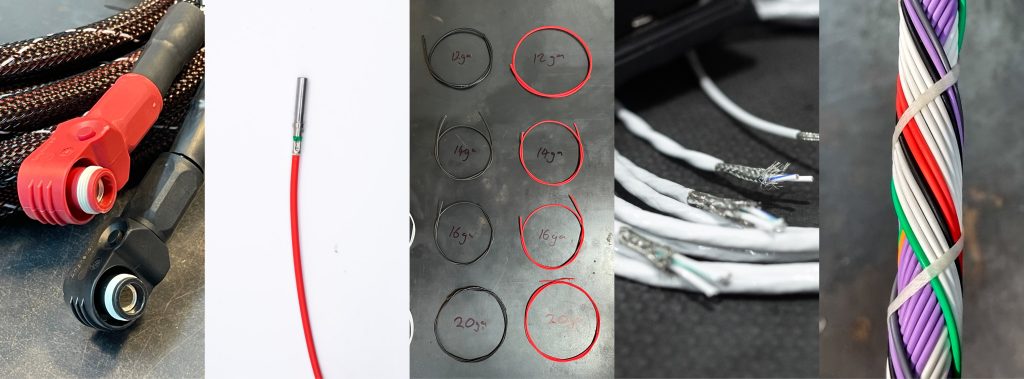
Every automotive wiring application is different, and because of this every wiring solution is unique. There are a number of factors to consider when choosing an appropriate wire size for use in your application.
While current draw is very important there are other factors to consider:
- Wire Length
- Ambient Temperature
- Free-to-air or Bundled
- Wire Construction
- Cost
You don’t want a harness that catches on fire due to not having adequate wire for the application, but you also don’t want to run 10AWG wire through the whole car, not only would it be incredibly cumbersome and heavy, it would be an expensive endeavour.
The below table is a general guide for automotive use (under 3m lengths), but as per the above factors, other considerations should be made before deciding on a wire size. This table was created for use with Spec 44 wire and may not be appropriate for other types of wire available.
Wire Size | Use Case | Current Rating (When Bundled) | Wire Size (mm²) | Diameter(mm) Including Insulation |
| 24AWG | Sensor wiring | 4A | 0.35 | 1.0 |
| 22AWG | Sensor wiring, small injectors, coil triggers, relay triggers | 6A | 0.74 | 1.2 |
| 20AWG | Sensor wiring, injectors, engine actuators (VVT solenoids etc), coil triggers, and lights (30w) | 8A | 0.8 | 1.4 |
| 18AWG | Small fans, pumps, coil pack power, motors (wiper/window), and lights (55w) | 11A | 1.3 | 1.6 |
| 16AWG | Fans, transfer/vacuum pumps, and lights (100w) | 16A | 1.7 | 1.8 |
| 14AWG | Medium duty fuel pumps, and small radiator fans | 17A | 2.6 | 2.2 |
| 12AWG | Heavy duty fuel pumps, and large radiator fans | 21A | 4.2 | 2.7 |
| 10AWG | Power distribution, and electric power steering pumps | 28A | 6.6 | 3.9 |
| 8AWG (1000V) | Power distribution | 55A | 15.2 | 5.2 |
| 6AWG (1000V) | Power distribution | 70A | 23.9 | 6.4 |
| 4AWG (1000V) | Power distribution | 95A | 38.0 | 7.8 |
This table isn’t the be-all and end-all, but it can help you get started. If you want to be more exact you can calculate the current requirements of what is being powered. Ohms Law can be used to determine what our current requirements are, if we again look at the injectors we can use the equation
Amps = Volts/Ohms
If we are going to use a set of Injector Dynamics ID1700x injectors we can look up the impedance which is 8.5ohms. While running our car should be providing around 14 volts. Therefore our current is equal to
Amps = 14/8.5
Amps = 1.65
This means our peak current draw from the injectors will be 1.65A, using the table above, we can easily run each injector on a 20AWG wire.
We can also calculate what size wire we need for items which draw a larger current, like the ignition coils. As an example Haltech IGN-1A coils can draw up to 15A of peak current. Using this peak current will cause us to over-spec our wiring, but can help us to find a ball-park figure. Below is a table showing the effective current draw at 100% duty cycle at different RPMs.
| RPM | Current (A) | Charge Time (ms) | Engine Cycle Time (ms) | Effective Current Draw at 100% Duty Cycle |
| 2000 | 15 | 4.5 | 60 | 1.125A |
| 4000 | 15 | 4.5 | 30 | 2.25A |
| 6000 | 15 | 4.5 | 20 | 3.375A |
| 8000 | 15 | 4.5 | 15 | 4.5A |
| 10,000 | 15 | 4.5 | 12 | 5.625A |
To calculate the above the formula is:
Effective current draw = (current * charge time) / engine cycle time
Referring to the top table, again we would run the ignition coils on a 20 AWG wire. If we needed a power wire to supply all coils we can calculate that as:
Total Amperage = Effective current draw * Number of coils
If we had a 4 cylinder engine revving to 8,000rpm, then our total maximum current for all 4 coils would be 18A.
At first glance this seems like we would need to run 12 AWG wire, but there are a few factors which can be taken into consideration. All 4 coils won’t be firing at once, and our calculations are based off the peak current draw rather than the average. On top of this, our rating table is for wire up to 3m in length, and a short run from the ECU to the coils will be less than this. With these combined factors, a 16AWG wire will be sufficient for this application.
As you can see, calculating wire size can be complicated, from finding the draw of various components to finding how long your wire lengths will be, there are a lot of factors to consider. As always PT Motorsport is here to help, and we are happy to answer any questions you might have about your project.
